On his third visit to the region Yoginder Sikand avoids the tourist trails of the Ladakh district which encompasses a massive 70 percent of the state of Jammu and Kashmir, but hosts less than 2 percent of its population
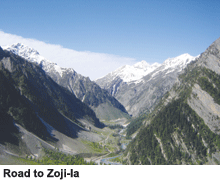 The road from Srinagar in Kashmir towards Leh, the administrative capital of Ladakh district in the state of Jammu & Kashmir, winds its way upwards out of the lush pasturelands of Baltal, in Kashmir’s northern Ganderbal district. From vertiginous heights, the valley is fast reducing to a distant flash of green, set in a bowl ringed by towering snow-clad peaks. Down below, a steel-grey river fed by glacial streams that tumble out of unknown crevices hidden high up in the mountains, cascades through the valley.
The road from Srinagar in Kashmir towards Leh, the administrative capital of Ladakh district in the state of Jammu & Kashmir, winds its way upwards out of the lush pasturelands of Baltal, in Kashmir’s northern Ganderbal district. From vertiginous heights, the valley is fast reducing to a distant flash of green, set in a bowl ringed by towering snow-clad peaks. Down below, a steel-grey river fed by glacial streams that tumble out of unknown crevices hidden high up in the mountains, cascades through the valley.
Rough, narrow, treacherous, and strewn with enormous boulders, the hazardous road winds its way up to Zoji-la, which, at 12,000 ft above mean sea level (msl), is the only motorable pass leading from the verdant Kashmir Valley to the icy wastelands of Ladakh. Salim, our driver, insists we press on, but I stop, awed by the unspoilt beauty of the landscape. From the edge of a sharp precipice the view is stunning: frozen mountains below a luminous blue sky, from which a majestic eagle swoops into a deep ravine, having spotted a hapless prey. A howling icy wind stings my face.
Twenty years ago, when I had traversed this very road — National Highway 1 D — my bus was almost the only vehicle I saw on the road to Zoji-la. Today, hundreds of vehicles — trucks, buses, vans and cars — jostle each other on the narrow highway. No longer is entering this pass leading to the Roof of the World as thrilling an adventure as it was once.
Descending the Zoji-la, we crawl through a massive, kilometre-long corridor, bound on either side by giant blocks of solid ice. Although it’s mid-June, the peak of summer, the ice is firm and deep. The corridor opens into an enormous snow field, studded with giant rocks, and then we are in gently undulating green pastures, breeding grounds of wooly sheep and bearded goats. Ponies and mules gam-bol in the pale summer light and plumes of purple smoke emanate from the goat-hair tents of nomadic shepherds. The mountains which ring the pastures are covered with snow, but even at a forbidding height of 15,000 ft, they seem eerily dwarfed, because the road we are on is itself almost as elevated.
Further down, the road passes through tiny settlements of flat-roofed mud-brick buildings set among fields bursting with buckwheat and lined with apricot trees. Their inhabitants are, for the most part, Dardi Muslims, said to be of Afghan descent. It is a picture postcard scene of perfect serendipity, but Salim says we can’t stop, not even for a photograph. We have to get to Kargil town by sundown.
We stop for tea at Drass. Second Coldest Inhabited Place on Earth, proclaims a signboard at the entrance to the town. Drass and its environs were the theatre of a bloody, short-lived Indo-Pak armed conflict over a decade ago. Memorials to fallen Indian soldiers and a war museum dot the town. Salim drives past several Dardi villages pointing to Tiger Hill and the Tololing Valley which witnessed the heaviest fighting. The landscape is austere with struggling valleys where even grass grows in mangy clumps. Yet, two nuclear-armed nations are squabbling over this unyielding real estate.
Crossing Drass, we enter Kargil proper — the land of the Baltis and Purig-pa people — Mongoloid by race and Shia Muslim by faith. I’ve consciously decided to avoid the touristy parts of Ladakh — Leh and its surrounding gompas, Buddhist monasteries, which I’ve already visited twice before. This time, I chose to explore Kargil district, which, together with Leh, makes up the sprawling Ladakh region of Jammu and Kashmir. Ladakh covers a massive 70 percent of the state’s area, but accounts for less than 2 percent of its population. Most of them are Muslims of the Shia persuasion, relatively recent converts from Buddhism.
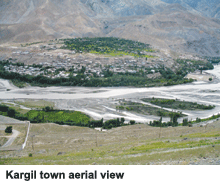 By early evening, when the sky turns from salmon-pink to ash grey, we arrive in Kargil town (pop.125,000). I scour the bazaar for a guesthouse, finally locating a grubby room for what I believe is an exorbitant price of Rs.400 per night. The room smells, its walls are damp and heavily stained with mildew, and the sheets are musty. But exhausted by the arduous journey, I drifted off to sleep as soon as I hit the pillow.
By early evening, when the sky turns from salmon-pink to ash grey, we arrive in Kargil town (pop.125,000). I scour the bazaar for a guesthouse, finally locating a grubby room for what I believe is an exorbitant price of Rs.400 per night. The room smells, its walls are damp and heavily stained with mildew, and the sheets are musty. But exhausted by the arduous journey, I drifted off to sleep as soon as I hit the pillow.
There isn’t much to see in Kargil, the largest urban habitat in Ladakh after Leh. I did the rounds of the town, picking up some Shia literature from the main mosque, visited the Qatal Gah, where, in the holy month of Muharram, devout Shias flagellate themselves to share the pain of the martyred Imam Hussain, grandson of the Prophet, and peeped into a couple of imambaras which house long poles draped with heavily embroidered votive flags. I did some necessary shopping for the trip ahead, including a bag bursting with apricots. Kargil’s apricots are rumoured to be the best in the world, so says the bearded old man who sells them to me.
At mid-day, I board a minibus heading to the village of Pannikhar (pop.300), a five-hour drive (60 km) to the east. The bus coughs and splutters its way up steep mountain roads. It seems to be running short of oxygen, like the rest of us. The road — if at all it can be called that — is a narrow, untarred path, pock-marked with yawning craters. It skims along the energetic Suru river which hurriedly rushes past till it disgorges itself into the Indus somewhere in Pakistani-administered Baltistan. The mountains are stark, but stained in a range of sombre hues — pale green, brilliant red, mustard yellow — with their cones burdened under winters of accumulated ice. Tiny settlements of stone and mud-brick huddle in the shadows of the mountains, surrounded by sparse circles of slender brochang and machang trees that dare to grow in this land far above the tree-line.
The J&K tourism department’s guesthouse in Pannikhar is a neat six-roomed wooden cottage. Bashir, the amiable caretaker, gives me a warm, thickly-carpeted room, and brings me a pot of lemon tea with a bowl of noodle soup, which I gratefully consume to ward off the bitter cold. At Rs.200 per day, I could hardly ask for more luxury. I am the only occupant of the guesthouse, the first visitor of the tourist season, and I bask in the solitude of the grave mountains surrounding me.
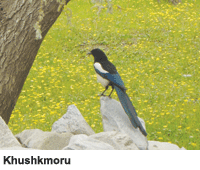 I spend the next four days in and around Pannikhar. Each morning I’m awoken by exciting chatter of the khushkmoru, a massive avian, half the size of a peacock, which I’m informed is found only on this side of the Zoji-la. It has a white body and a long black tail and sports a black feathery veil over its face. These birds are all over — traipsing in the beds of wild flowers that have sprouted in the little plot of parrot-green outside my room, hopping among slender, leafless poplars, and even marching into the kitchen, where Bashir feeds them grain and noodles. There’s no shortage of avians here — wood-peckers, sparrows, doves, swallows, and brilliantly-hued bipeds abound.
I spend the next four days in and around Pannikhar. Each morning I’m awoken by exciting chatter of the khushkmoru, a massive avian, half the size of a peacock, which I’m informed is found only on this side of the Zoji-la. It has a white body and a long black tail and sports a black feathery veil over its face. These birds are all over — traipsing in the beds of wild flowers that have sprouted in the little plot of parrot-green outside my room, hopping among slender, leafless poplars, and even marching into the kitchen, where Bashir feeds them grain and noodles. There’s no shortage of avians here — wood-peckers, sparrows, doves, swallows, and brilliantly-hued bipeds abound.
I spend the days exploring the village and its environs fortified by salted butter tea and samplings of tsampa, a dish of crushed barley and yoghurt shared with warm and welcoming village folk. Following their example, I wash my clothes in the stony bed of the river, and though my fingers turn numb and blue in the cold water, it is a wonderful therapy for the soul. I spend many happy hours visually exploring the Nun and Nun, sister peaks, both over 21,000 ft above msl which serve as the walls of the northern part of the valley, constituting a giant massif. In the afternoons, when chilly winds blow down the mountain slopes, I trace the accumulation of clouds whirling around their summits until they blot them out completely from view, and it begins to drizzle and snow, the ice coming down in soft feathery flakes.
One memorable day in the summer of 2010, I trekked all the way to the settlement of Sankoo, where, high up on the Himalayan slopes, I was rewarded with the rare sight of a party of curly-horned ibex leaping sure-footed from crag to crag. I also spotted a band of Himalayan marmots — large, beige-hued beaver-like rodents, gamboling on the banks of a glacial stream. At even fall as I walked back towards Pannikhar, I was offered a lift by a truck driver who warned against prowling wolves and leopards and insisted upon saving me from them. That evening, after I reached Pannikhar, Bashir excitedly informed me that a bear was spotted on a ridge just above the village earlier that afternoon. At night, Bashir shakes me awake, just in time for me to glimpse a pair of slender foxes trotting along a mud path leading from the guesthouse into the mountains beyond.
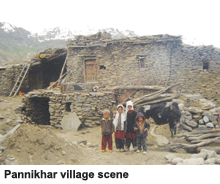 Much of my time was expended conversing with the local gentry in whom I observed remarkable changes since my last expedition to the region two decades ago. All I can recall of that visit was endemic poverty, and isolated villages unconnected with the outside world. The conditions have transformed radically. Roads, schools and medical centres have been built, there are fewer yaks now, most of them replaced by cars and jeeps. Youngsters wear jeans and T-shirts, and sport cell phones. Literacy rates have soared and many locals now work for the government. Old stone houses constructed from local material have been replaced by ‘modern’ cement structures.
Much of my time was expended conversing with the local gentry in whom I observed remarkable changes since my last expedition to the region two decades ago. All I can recall of that visit was endemic poverty, and isolated villages unconnected with the outside world. The conditions have transformed radically. Roads, schools and medical centres have been built, there are fewer yaks now, most of them replaced by cars and jeeps. Youngsters wear jeans and T-shirts, and sport cell phones. Literacy rates have soared and many locals now work for the government. Old stone houses constructed from local material have been replaced by ‘modern’ cement structures.
But all change in Kargil and Ladakh hasn’t been for the better. The glaciers here are melting rapidly, shortening by a few feet every year. “It doesn’t snow as heavily as in the past,” says Khalil Wani, a village elder. “Earlier, the snow blocked entry into our valleys for nine months every year, but now it lasts for just six months.” He points to the bare slopes of the surrounding mountains. “When I was a child, they were covered with glacial ice, several feet deep, throughout the year, but now they are naked,” he remarks.
But global warming has meant that more trees and a greater variety of crops, such as peas, potatoes, carrots and cauliflower, grow in the region.
Another memorable day was spent with a family of nomadic Gujjar shepherds, who had set up camp in a nalla, a narrow valley, just behind Pannikhar. Naseem Khan is the quintessential patriarch, who wears a ponderous turban on his head, sports a richly hennaed beard, neatly oiled whiskers and peers through haunting green eyes. The rest of the party consists of younger men, children and women. Their pack animals comprise a dozen or so mules and horses, richly caparisoned with patchwork quilts and colourful tassles. A pair of hairy Tibetan mastiffs guards their tents at night against predatory wolves.
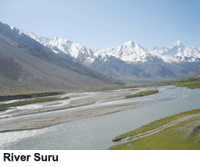 In contrast to the Gujjars of Jammu and the Indian mainland who rear cows and buffaloes, the Gujjars of Kashmir tend sheep and goats. Each clan has its own settled migratory route, established by their ancestors and closely followed, century after century, down to the present. Every summer, Naseem Khan’s clan comes to Kargil from Anantnag in southern Kashmir, a five-day trek through treacherous defiles in the mountains. Although the grass in Pannikhar and its surroundings is sparse, it’s rich in nutrients, leading to rapid hair growth and extra milk production in his animals, he says. The nomadic Gujjars and resident villagers have a complex mutually-supportive relationship, sealed through centuries of tradition and exchange. The villagers permit Gujjars to graze their flocks on their pastures, in return for which they get free manure, milk, wool, and on occasion, a free animal. The Gujjars take on the animals of the villagers to graze, in return for a fee. Naseem and his family will camp behind Pannikhar until September, when the first flurry of snow forces them to begin their return journey to Kashmir and then all the way to the plains of Jammu and Punjab, a trek of over a month.
In contrast to the Gujjars of Jammu and the Indian mainland who rear cows and buffaloes, the Gujjars of Kashmir tend sheep and goats. Each clan has its own settled migratory route, established by their ancestors and closely followed, century after century, down to the present. Every summer, Naseem Khan’s clan comes to Kargil from Anantnag in southern Kashmir, a five-day trek through treacherous defiles in the mountains. Although the grass in Pannikhar and its surroundings is sparse, it’s rich in nutrients, leading to rapid hair growth and extra milk production in his animals, he says. The nomadic Gujjars and resident villagers have a complex mutually-supportive relationship, sealed through centuries of tradition and exchange. The villagers permit Gujjars to graze their flocks on their pastures, in return for which they get free manure, milk, wool, and on occasion, a free animal. The Gujjars take on the animals of the villagers to graze, in return for a fee. Naseem and his family will camp behind Pannikhar until September, when the first flurry of snow forces them to begin their return journey to Kashmir and then all the way to the plains of Jammu and Punjab, a trek of over a month.
Naseem worries about the future of his people. He complains about youngsters getting influenced by the lure of cities, who wish to settle down in one place, get an education and land a government job. “They think our constant moving, from place to place, is backward,” he rues.
It’s with a heavy heart that I leave Pannikhar. After almost a week in the far flung, isolated hamlets of the Suru Valley, which few outsiders care to visit, I head back to Kargil and from there to Leh, which is where I change from pristine wilderness to frenzied urban chaos — a lifestyle I don’t like, but which I can’t do without.